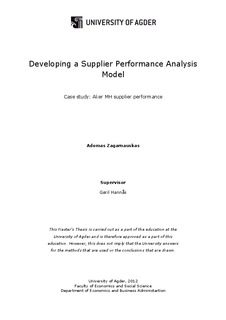| dc.description.abstract | This master thesis focuses on the use Data Envelopment Analysis (DEA) for measuring supplier performance. Goal of the study is to apply a mathematical model for supplier performance measurement which would be able to handle multi-criteria. To test the model in practice, cooperation was established with case study firm (Aker Maritime Hydraulics), which is providing drilling engineering solutions to Oil & Gas industry. Proposing the model for measuring performance of existing suppliers not only demonstrates how DEA can be applied, but also sets the grounds for supplier performance improvement process in a case study firm. At the same time, this thesis makes a small contribution to academic literature on supplier performance measurement by introducing an application in new setting. To reach the goal of the study, the following Research Question is defined: How can Data Envelopment Analysis be used as tool for measuring supplier performance?
After the early works related to supplier performance evaluation (Dickson (1966), Lambertson et al (1976)), this field received increasing attention. Mathematical model called Data Envelopment Analysis and developed by Charnes, Cooper and Rhodes (1978) was adopted as one of the tools for measuring supplier performance and resulted in multiple academic articles regarding different application settings and model extensions, e.g. Weber and Desai (1996), Narasimhan et al (2001), Talluri et al (2006), Zeydan et al (2011) etc. Applications of DEA covered various settings - first public, then private organizations. To the best of knowledge, DEA was not applied for supplier performance evaluation in Norwegian Oil & Gas industry related technology firm. In addition, this thesis presents an extended approach of measuring suppliers‘ relative performance by comparing perceived Ideal supplier and existing suppliers based on performance.
In this thesis, suppliers‘ performance was measured in terms of efficiency in utilizing inputs (supplier‘s average price trend over 5 years) to produce outputs (quality, delivery precision, invoice matching to purchase order). Out of 19 suppliers analyzed, DEA identified 2 efficient suppliers. Ideal Supplier, when included in the model, was identified as efficient, together with the same two efficient units that were identified in first application. Findings revealed that three worst performing suppliers accounted for more than half of firm‘s total spending towards a supplier group, while best five accounted for only 12.4%.
Criteria that both Aker MH used for supplier performance measurement and also this study used for DEA application (price, delivery, quality) is consistent with academic research 4
results on most important supplier evaluation criteria (Dickson, 1966) and most often used criteria for supplier evaluation in academic research (Weber et al 1991). | no_NO |
